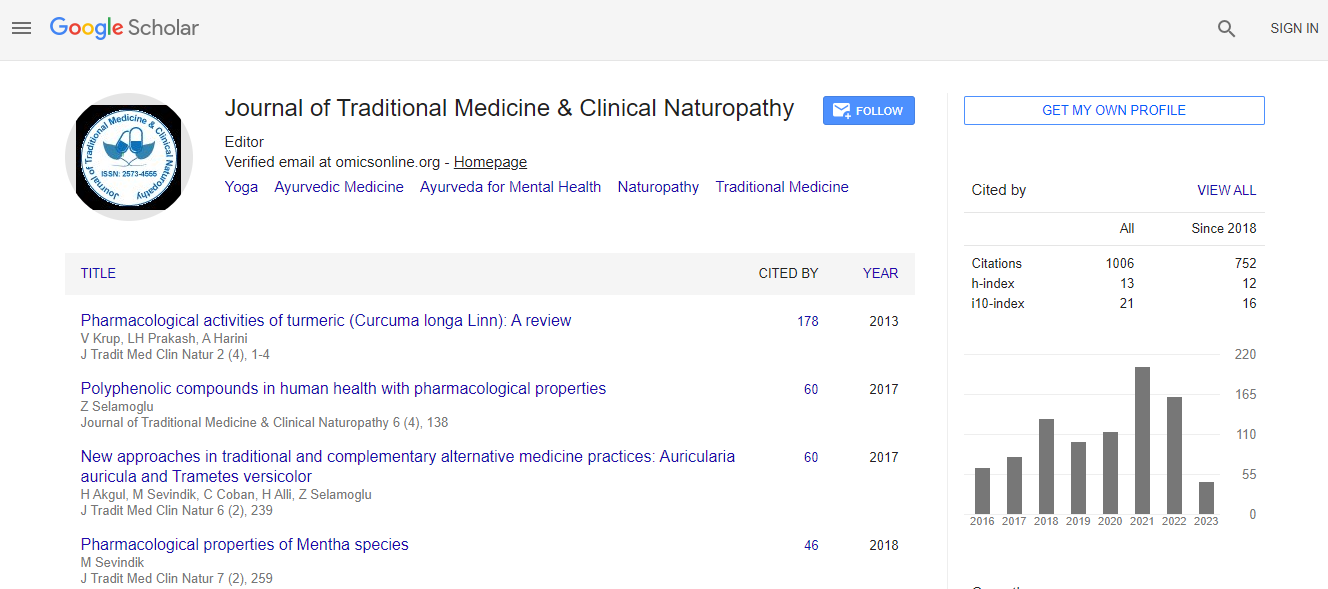Our Group organises 3000+ Global Conferenceseries Events every year across USA, Europe & Asia with support from 1000 more scientific Societies and Publishes 700+ Open Access Journals which contains over 50000 eminent personalities, reputed scientists as editorial board members.
Open Access Journals gaining more Readers and Citations
700 Journals and 15,000,000 Readers Each Journal is getting 25,000+ Readers
Google Scholar citation report
Citations : 1504
Journal of Traditional Medicine & Clinical Naturopathy peer review process verified at publons
Indexed In
- CAS Source Index (CASSI)
- Google Scholar
- Sherpa Romeo
- Open J Gate
- Genamics JournalSeek
- RefSeek
- Directory of Research Journal Indexing (DRJI)
- Hamdard University
- EBSCO A-Z
- Publons
- Geneva Foundation for Medical Education and Research
- Euro Pub
- ICMJE
Useful Links
Recommended Journals
Related Subjects
Share This Page
Post-traumatic stress disorder and the toxicology of Cannabis sativa
Joint Meeting on 2nd World Congress on Traditional & Complemenatry Medicine & 2nd International Conference on Herbal & Traditional Medicine
Bruno O Onyemegbulem,Onunekwu O Charles, Yusuf N Omeh and J C Aguiyi
University of Jos, NigeriaMichael Okpara University of Agriculture Umudike, Nigeria
ScientificTracks Abstracts: J Tradit Med Clin Natur
Abstract
Many young men, women and even the elderly are addicted to Cannabis intake abuse despite its predictable toxicological consequences. In this study we studied the toxic effects of oral administration of methanol extract of Cannabis sativa seeds using total of forty male Wistar rats. Animals randomized were into five groups (n=8 rats) of approximately equal weight. Group-1 received 100 mg/kg of the of the extract, group-2 received 200 mg/kg of the extract, group-3 received 300 mg/kg dosage of the extract, group-4 received 2 ml of virgin olive oil (vehicle control) and group-5 received distilled water (normal control) for 14 days. The rationale behind the vehicle control group is to show that the vehicle did not have any extra cytological/histological effect. The proximate properties show: Moisture content (6.69±0.14%), protein content (19.10±0.01%), ash content (11.84±0.02%), fat (19.33±0.00%), crude fiber (18.87±0.00%), carbohydrate (43.04%), dry matter (80.91±0.14%) and oil absorption capacity (1.87±0.00%). The anti-nutrients were as follows: alkaloids (3.15±0.01 mg/100 g), flavonoids (2.82±0.01 mg/100 g), saponins (6.10±0.01%), tannins (2.14±0.01 mg/100 g), cyanogenic glycosides (0.10±0.01 mg/100 g) and phenols (0.27±0.01 mg/100 g). The mineral content of the sample were potassium (13.73±0.01 mg/100 g), phosphorus (10.00±0.02 mg/100 g), sodium (17.53±0.01 mg/100 g), calcium (14.65±0.01 mg/100 g), magnesium (09.67±0.01 mg/100 g), zinc (2.00±0.01 mg/100 g) and Iron (1.00±0.01 mg/100 g). Result for AST was significantly (p<0.05) higher in group-2 (57.00±13.00 IU/L) and group-3 (59.33±10.53 IU/L), when compared with the normal control group-5 (31.33±1.53 IU/L). Significantly (p<0.05) higher serum ALT was observed in treatment group-2 (50.00±12.52 IU/L) and group-3 (56.33±10.21 IU/L). The results for kidney function, shows significantly (p<0.05) higher serum urea concentration in group-3 (13.75±2.41 mg/dl) when compared with the normal control group (8.75±1.60 mg/dl). Serum creatinine concentration was significantly (p<0.05) higher in group-2 (2.25±1.18 mg/kg) and group-3 (2.38±1.57 mg/kg) when compared with the normal control group (1.09±0.13 mg/kg). Significantly (p<0.05) higher SOD values was obtained in group-3 (72.64±5.90 mg/kg) when compared with normal control group (19.62±4.26 mg/kg). There was no significant (p<0.05) difference in total serum protein concentration in all groups when compared with the normal control group. The histological result shows that the oral administration of Cannabis sativa induced pronounced inflammation of the hepatic and renal tissue in group-3 when compared with the normal control group. In conclusion, the study showed that oraladministration of Cannabis sativa caused dose dependent hepatorenal toxicity.Biography
Bruno O Onyemegbulem is the specialist of philosophy. He is associated with the African Center of Excellence in Phytomedicine Research and Development University of Jos as a research fellow. He is the member of National Association of Mathematical Physics (NAMP), Nigerian Mathematical Society (NMS) and Nigerian Society for Mathematical Biology (NSMB). He is the author of "A Mathematical Modelling of the Effect of Treatment in the Control of Malaria in a Population with Infected Immigrants".
E-mail: charlesonunekwu@outlook.com

 Spanish
Spanish  Chinese
Chinese  Russian
Russian  German
German  French
French  Japanese
Japanese  Portuguese
Portuguese  Hindi
Hindi 
